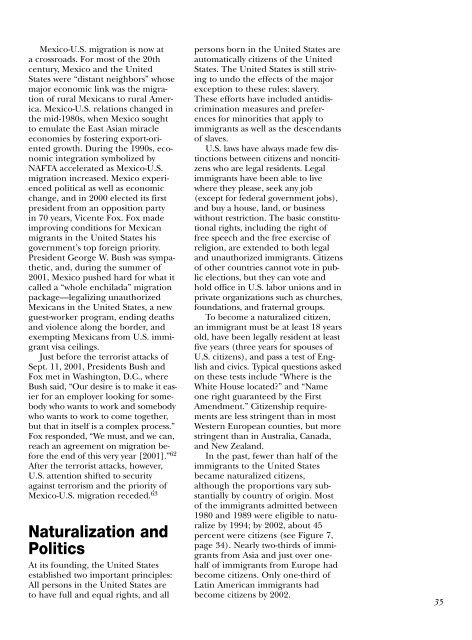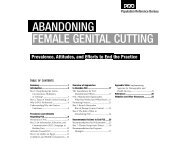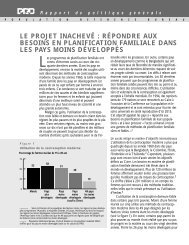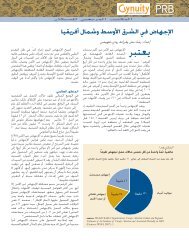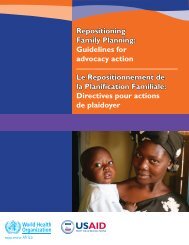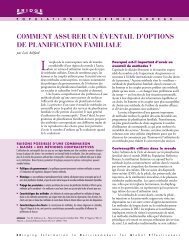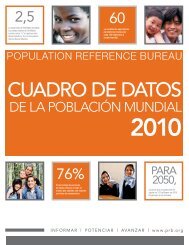Immigration Shaping America - Population Reference Bureau
Immigration Shaping America - Population Reference Bureau
Immigration Shaping America - Population Reference Bureau
You also want an ePaper? Increase the reach of your titles
YUMPU automatically turns print PDFs into web optimized ePapers that Google loves.
Mexico-U.S. migration is now at<br />
a crossroads. For most of the 20th<br />
century, Mexico and the United<br />
States were “distant neighbors” whose<br />
major economic link was the migration<br />
of rural Mexicans to rural <strong>America</strong>.<br />
Mexico-U.S. relations changed in<br />
the mid-1980s, when Mexico sought<br />
to emulate the East Asian miracle<br />
economies by fostering export-oriented<br />
growth. During the 1990s, economic<br />
integration symbolized by<br />
NAFTA accelerated as Mexico-U.S.<br />
migration increased. Mexico experienced<br />
political as well as economic<br />
change, and in 2000 elected its first<br />
president from an opposition party<br />
in 70 years, Vicente Fox. Fox made<br />
improving conditions for Mexican<br />
migrants in the United States his<br />
government’s top foreign priority.<br />
President George W. Bush was sympathetic,<br />
and, during the summer of<br />
2001, Mexico pushed hard for what it<br />
called a “whole enchilada” migration<br />
package—legalizing unauthorized<br />
Mexicans in the United States, a new<br />
guest-worker program, ending deaths<br />
and violence along the border, and<br />
exempting Mexicans from U.S. immigrant<br />
visa ceilings.<br />
Just before the terrorist attacks of<br />
Sept. 11, 2001, Presidents Bush and<br />
Fox met in Washington, D.C., where<br />
Bush said, “Our desire is to make it easier<br />
for an employer looking for somebody<br />
who wants to work and somebody<br />
who wants to work to come together,<br />
but that in itself is a complex process.”<br />
Fox responded, “We must, and we can,<br />
reach an agreement on migration before<br />
the end of this very year [2001].” 62<br />
After the terrorist attacks, however,<br />
U.S. attention shifted to security<br />
against terrorism and the priority of<br />
Mexico-U.S. migration receded. 63<br />
Naturalization and<br />
Politics<br />
At its founding, the United States<br />
established two important principles:<br />
All persons in the United States are<br />
to have full and equal rights, and all<br />
persons born in the United States are<br />
automatically citizens of the United<br />
States. The United States is still striving<br />
to undo the effects of the major<br />
exception to these rules: slavery.<br />
These efforts have included antidiscrimination<br />
measures and preferences<br />
for minorities that apply to<br />
immigrants as well as the descendants<br />
of slaves.<br />
U.S. laws have always made few distinctions<br />
between citizens and noncitizens<br />
who are legal residents. Legal<br />
immigrants have been able to live<br />
where they please, seek any job<br />
(except for federal government jobs),<br />
and buy a house, land, or business<br />
without restriction. The basic constitutional<br />
rights, including the right of<br />
free speech and the free exercise of<br />
religion, are extended to both legal<br />
and unauthorized immigrants. Citizens<br />
of other countries cannot vote in public<br />
elections, but they can vote and<br />
hold office in U.S. labor unions and in<br />
private organizations such as churches,<br />
foundations, and fraternal groups.<br />
To become a naturalized citizen,<br />
an immigrant must be at least 18 years<br />
old, have been legally resident at least<br />
five years (three years for spouses of<br />
U.S. citizens), and pass a test of English<br />
and civics. Typical questions asked<br />
on these tests include “Where is the<br />
White House located?” and “Name<br />
one right guaranteed by the First<br />
Amendment.” Citizenship requirements<br />
are less stringent than in most<br />
Western European counties, but more<br />
stringent than in Australia, Canada,<br />
and New Zealand.<br />
In the past, fewer than half of the<br />
immigrants to the United States<br />
became naturalized citizens,<br />
although the proportions vary substantially<br />
by country of origin. Most<br />
of the immigrants admitted between<br />
1980 and 1989 were eligible to naturalize<br />
by 1994; by 2002, about 45<br />
percent were citizens (see Figure 7,<br />
page 34). Nearly two-thirds of immigrants<br />
from Asia and just over onehalf<br />
of immigrants from Europe had<br />
become citizens. Only one-third of<br />
Latin <strong>America</strong>n immigrants had<br />
become citizens by 2002.<br />
35


